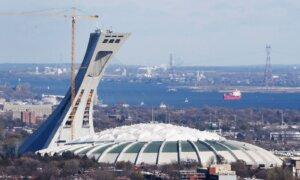Caroline Proulx released the estimate earlier this week as she presented a comparatively cheaper plan to spend $870 million to replace the unstable and hazardous roof of the stadium built for the 1976 Olympic Games. The venue can’t hold games or exhibitions half the year because of the roof’s fragility—events are cancelled if more than three centimetres of snow are forecast.
But throughout the years, Quebec politicians have said that the only reasonable option is to continue maintaining the stadium—even if its roof has never really worked since it was completed in 1987—than to get rid of the concrete behemoth in the city’s east-end.
“It’s certainly more than I’ve ever heard of for a stadium teardown,” said Victor Matheson, an economics professor with College of the Holy Cross in Worcester, Mass., who specializes in sports economics.
In Atlanta, Ga., for example, a domed football stadium was replaced in 2017 with the cost of demolition and construction estimated at US$1.6 billion.
“The fact that in Atlanta you can build an entirely new stadium and tear down the old one for the same price of just tearing down the one in Montreal seems concerning,” Mr. Matheson said.
The cost of bringing down a sports venue can vary widely. In 2017, an Ontario company was awarded $2.1 million to demolish Regina’s 33,350-seat football stadium; other demolitions have been more expensive. In Washington, D.C., the Robert F. Kennedy Memorial Stadium was demolished at a cost of US$20 million in 2023, according to local media.
A 2009 report commissioned by the provincial agency that manages Montreal’s Olympic Stadium put the cost of demolition at up to $700 million—about $965 million when adjusted for inflation.
One of the factors pushing the cost of demolition up, according to the report, is that the Olympic Stadium can’t be imploded with explosives. Because the stadium is composed of pre-stressed concrete, it says, controlled explosions could send blocks of concrete flying hundreds of metres, kick up a cloud of dust and lead to a shock wave that could damage an adjacent indoor zoo and a subway tunnel underneath.
The report, prepared by engineering consultancy Séguin Ingénierie, also rules out demolition with a wrecking ball. The company behind the report, which would later change its name to Génius Conseil, ceased commercial operations in 2014, one year after its president told a public inquiry about a system of collusion and kickbacks in provincial government contracting. In 2020, it agreed to pay $300,000 to settle bid-rigging charges brought by the federal government.
Daniele Malomo, a civil engineering professor at McGill University, said it’s impossible to estimate the cost of the demolition without an extensive evaluation, but he said the use of pre-stressed concrete makes the job more complex.
Pre-stressed concrete is less susceptible to cracking and more resistant to bending, but the rebar wire within is under tension and if the concrete is cut, energy will be released, he said. “It will behave like a bomb, essentially.”
Reducing the tension and removing the rebar wires would be a lengthy process, he said.
Bruno Massicotte, a civil engineering professor at Polytechnique Montréal, said that the infrastructure under the stadium—such as the subway—rules out the use of explosives. “The uniqueness of this structure will necessarily push costs up compared to other types of stadium,” he wrote in an email. “But the justification for the $2 billion was not presented.”
Parc olympique said in an email that beyond the cost to dismantle the stadium’s 12,000 concrete components, the $2-billion estimate includes $158 million for inflation, $168 million for “minimal site restoration” and $80 million to restore nearby roads after trucks have passed between 20,000 and 30,000 times during the demolition.
The priciest estimated stadium demolition in North America, after Montreal, might be in Houston, Texas, where the projected cost has been as high as almost US$80 million to demolish the Astrodome. There, community members secured state heritage status for the venue, which was the world’s first domed stadium when it was built in 1965.
James Glassman, the founder of preservation group Houstorian, said many Houston residents have fond memories of sporting events or concerts in the stadium, which has become one of the city’s few historical landmarks.
But with National Football League and Major League Baseball teams that once called the stadium home long gone— he NFL team left the city in 1996 and the MLB team has been playing at a new stadium since 1999—community organizations are trying to find creative new uses for the structure, he said.
“Once it’s gone, it’s gone forever, so be careful, it’s easy to kind of get caught up in demolition fever, but who pays to knock it down? Who benefits? What’s going up in its place? If that land is needed for something else, there’s a compelling reason, but, if not, allowing it to sort of stand isn’t a terrible solution,” Mr. Glassman said.







